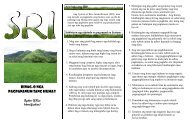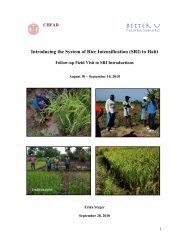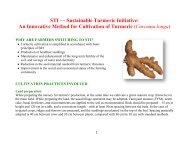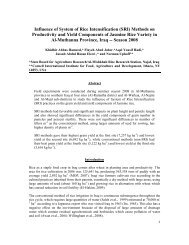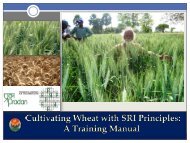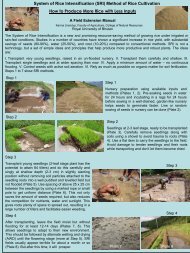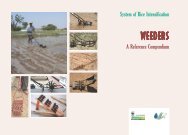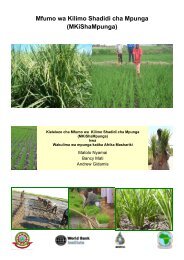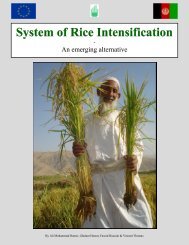EFFECT OF THE SYSTEM OF RICE INTENSIFICATION (SRI) ON ...
EFFECT OF THE SYSTEM OF RICE INTENSIFICATION (SRI) ON ...
EFFECT OF THE SYSTEM OF RICE INTENSIFICATION (SRI) ON ...
Create successful ePaper yourself
Turn your PDF publications into a flip-book with our unique Google optimized e-Paper software.
2006). Hence both nutrient uptake is higher and competition due to nutrients is lower than in a<br />
traditional field with 5-6 seedlings per hill. Normally the narrow spacing of transplants in<br />
conventional fields will produce fewer tillers app. 8-13 per plant (Stoop et al., 2002), although this<br />
will depend on soil and management practices and the used varieties. However for the conditions in<br />
Cambodia it was observed that traditional fields often had a little more than 10 tillers per plant<br />
whereas <strong>SRI</strong> plants often had a few more tillers. It is however notable here that most farmers did<br />
not transplant younger seedlings to their <strong>SRI</strong> fields (1 farmer mentioned he used younger<br />
seedlings). It is then remarkable that the difference in yields is more than 1 t. If farmers used<br />
younger seedlings the difference in yield could have related to uprooting damage from the seedbed<br />
as younger seedlings will be less damaged by uprooting upon transplanting (Yoshida, 1981). Young<br />
seedlings used in <strong>SRI</strong> are also believed to be more easily adapting to the new environments found in<br />
the field and the “stress” involved in transplanting (Kabir, 2006).<br />
The competition between the plants might have an effect on the yield potential – also called<br />
intraspecific competition which is competition between plants of the same species and is very much<br />
depending on density (Antonovics & Levin, 1980). Kawano et al. (1974) state that in soils low in N<br />
content, rice plants will first compete for the soil Nitrogen and later light which is vice versa in soils<br />
high in N content. Kawano et al. (1974) further conclude from trials in Peru on spacing and<br />
intraspecific competition involving 25 different varieties that in soils low in N content, wider<br />
spacing is beneficial which especially is suitable for vigorous tall growing varieties with long<br />
growth duration. With the given low N containing soils in Prey Veng, the wider spacing might thus<br />
have caused a yield increase in the <strong>SRI</strong> field as compared to the traditional fields.<br />
The competition from weeds could not have caused the differences in yield as weed problems are<br />
low in the traditional systems due to dense spacing and in the <strong>SRI</strong> fields hand weeding was done<br />
regularly by most farmers. Koma (2007) states that farmers can obtain higher yields with <strong>SRI</strong>, even<br />
if they only manage some of the concepts.<br />
Given these yield increases is also one of the reasons why farmers would like to continue with <strong>SRI</strong><br />
for the next season. Figure 15 pictures main reasons why farmers would like to continue with <strong>SRI</strong><br />
next year. However, when farmers were interviewed, only one household had harvested and the<br />
farmers could therefore not have experienced the increase in yield. This illustrates how confident<br />
56



